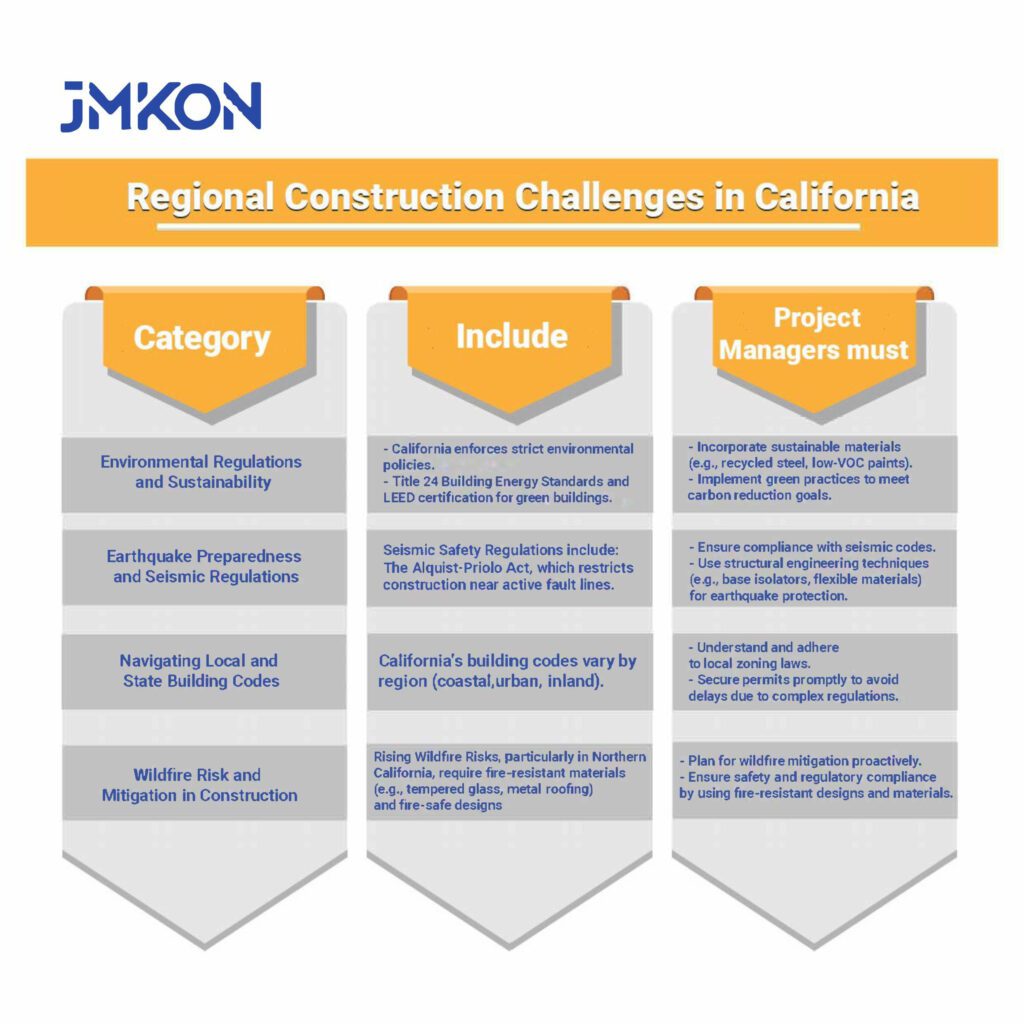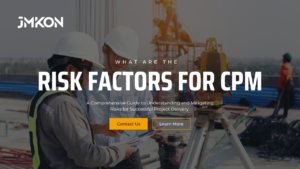California is home to one of the most dynamic construction industries in the world, driven by a combination of economic growth, population expansion, and the need for modern infrastructure. The state’s diverse geography, ranging from bustling coastal cities like Los Angeles and San Francisco to more rural inland areas, presents unique challenges for construction projects.
In coastal regions, there’s a constant demand for building in high-density urban environments, often with limited space and strict environmental regulations. Inland, the challenges shift to include vast agricultural areas and a growing need for residential and commercial developments in less populated regions.
California’s booming tech industry, centered in Silicon Valley, continues to push the demand for high-tech office buildings and innovative workspaces. Meanwhile, the housing crisis and need for affordable housing solutions create a constant demand for residential projects across the state.
This combination of geographic diversity, economic strength, and evolving infrastructure needs makes construction in California a complex yet highly rewarding field. Successful construction project management in this state requires a deep understanding of local regulations, environmental considerations, and the ability to adapt to the varied demands of each region.
Regional Construction Challenges in Construction industry

California’s construction industry faces a wide range of challenges, each unique to the state’s diverse regions.
From Southern California’s sprawling urban centers to Northern California’s tech-driven cities and the agricultural heartland of Central California, effective construction project management must adapt to the specific demands of each area.
Southern California (Los Angeles, San Diego)
- Cities like Los Angeles and San Diego are characterized by extensive urban sprawl, where growth stretches outward into suburban areas. This presents challenges such as managing large-scale developments while minimizing environmental impact.
- Additionally, the region’s proximity to the Pacific Ocean brings strict environmental regulations to protect coastal ecosystems, adding complexity to construction planning.
- One of the most critical challenges is earthquake retrofitting. Southern California sits on multiple fault lines, making it essential to construct buildings that meet strict seismic safety standards.
- Project managers must ensure that new structures, as well as retrofits of older buildings, comply with regulations designed to withstand potential earthquakes.
Northern California (San Francisco, Silicon Valley)
- Northern California, particularly in cities like San Francisco and Silicon Valley, presents a different set of challenges. The region is notorious for high-density urban development, where space is limited, and land costs are extremely high.
- This forces developers to build upward, leading to complex high-rise projects in tight urban spaces. Effective project management here requires precise CPM scheduling services, coordination with local agencies, and a focus on minimizing disruptions in crowded areas.
- Another key challenge is building in earthquake-prone zones. Similar to Southern California, Northern California lies along major fault lines, including the San Andreas Fault, making earthquake-resilient construction essential.
- Additionally, managing the high cost of land and construction materials in this tech-driven region adds another layer of complexity to projects.
Central California (Fresno, Sacramento)
- In contrast to the urban challenges of Southern and Northern California, Central California is characterized by its vast rural areas and agricultural infrastructure.
- Construction projects in cities like Fresno and Sacramento often focus on rural development, from building new housing to supporting agricultural industries with essential infrastructure.
- One of the major challenges in Central California is the arid climate, which requires sustainable building practices that conserve water and energy.
- Project managers in this region must prioritize eco-friendly materials and designs, ensuring compliance with California’s stringent sustainability standards.
- Additionally, the spread-out nature of rural developments means that efficient transportation and logistics planning are critical to keeping projects on time and within budget.
Across California’s diverse regions, construction projects require careful planning, a deep understanding of local challenges, a commitment to sustainability and safety and construction scheduling software.
Each region demands a unique approach, but with skilled project management, these challenges can be successfully navigated to deliver high-quality results.
Key Factors for Successful Construction Project Management in California

Environmental Regulations and Sustainability:
California Enforces Strict Environmental Policies, including:
- Title 24 Building Energy Standards.
- LEED certification requirements for green buildings.
Project Managers must:
- Incorporate sustainable materials like recycled steel, low-VOC paints, and energy-efficient systems.
- Implement green construction practices to meet the state’s carbon reduction goals.
Earthquake Preparedness and Seismic Regulations:
California’s Seismic Safety Regulations include:
- The Alquist-Priolo Act, which restricts construction near active fault lines.
Project Managers must:
- Ensure compliance with seismic safety codes.
- Use advanced structural engineering techniques, such as base isolators and flexible building materials, to protect buildings in earthquake-prone areas.
Navigating Local and State Building Codes:
California’s building codes vary by region and city:
- Differences exist between coastal, urban, and inland regulations.
Effective Project Management includes:
- Understanding and adhering to local land use and zoning laws.
- Securing timely permits, avoiding delays due to California’s complex regulatory environment.
Wildfire Risk and Mitigation in Construction:
Increasing Wildfire Risks, Especially in Northern California, require:
- The use of fire-resistant materials like tempered glass, metal roofing, and non-combustible siding.
- Incorporating fire-safe designs, such as defensible space around buildings and sprinkler systems.
Project Managers must:
- Proactively plan for wildfire mitigation in construction, ensuring both safety and regulatory compliance.
The Importance of Effective Resource Management
Labor Shortages and Unionized Workforces:
Addressing Labor Shortages:
- California’s booming urban centers, such as Los Angeles and San Francisco, face significant labor shortages due to high construction demand.
- Project managers need to develop effective recruitment strategies and build relationships with local labor pools to ensure adequate staffing.
Navigating Unionized Workforces:
- California’s construction industry is heavily unionized, requiring compliance with specific labor laws, including wages, benefits, and work hour regulations.
- Skilled project managers ensure smooth collaboration with unions to avoid disputes, project delays, and ensure adherence to safety protocols.
Sourcing Sustainable Materials:
Eco-Friendly Building Materials:
- California’s strict environmental laws drive the need for sustainable materials like recycled steel, reclaimed wood, and energy-efficient insulation.
- Project managers must prioritize sourcing eco-friendly materials to meet state regulations and LEED certification requirements.
Procurement Strategies:
- Effective procurement involves identifying suppliers that provide sustainable materials, while managing cost and availability to keep projects on track.
- Adherence to California’s sustainability goals, including carbon footprint reduction, is critical in managing long-term project success.
Why Choose JMKON for Construction Project Management in California

Local Expertise
JMKON has extensive experience managing projects across California’s diverse regions, adapting to the unique demands of each environment.
JMKON’s deep understanding of California’s geographic and regulatory challenges ensures that projects are completed efficiently, safely, and in compliance with local standards.
Strong Relationships
This approach allows us to streamline processes, address challenges proactively, and deliver quality outcomes on time. It’s this commitment to purposeful collaboration that sets us apart and enables us to make things happen. We’re not just managing projects; we’re building pathways to success.
Experience in Managing Complex Projects
JMKON has a proven track record of managing a wide range of challenging construction projects in California, from seismic retrofitting to green building initiatives.
- Seismic Retrofitting: Expertly handled projects requiring compliance with California’s stringent earthquake safety standards, ensuring structures are built to withstand seismic activity.
- Large-Scale Infrastructure Projects: Successfully managed complex infrastructure projects, from highways to urban transit systems, delivering on time and within budget while overcoming California’s unique construction challenges.
Choosing JMKON means partnering with a team that combines local expertise, strong relationships, and proven experience to deliver construction projects that meet California’s highest standards.
Factors Affecting Construction Project Management Costs in California
Land and Real Estate Prices:
High Land Costs:
- Urban centers like Los Angeles and San Francisco are known for their exceptionally high real estate prices, making land acquisition one of the biggest expenses in construction projects.
- This drives up the overall project budget, as developers must factor in the high costs of purchasing or leasing land before even beginning construction.
Budget Impact:
- Limited space in urban areas forces developers to plan carefully, often opting for vertical expansion (high-rises), which can increase both construction complexity and costs.
- Project managers must balance real estate prices with construction costs to stay within budget while delivering the project’s required scope.
Environmental Impact Costs:
Stringent Environmental Regulations:
- California has some of the toughest environmental standards in the country, which requires builders to meet strict energy efficiency, water conservation, and carbon offset goals.
- Complying with these regulations often involves higher initial costs, such as installing energy-efficient systems or sourcing sustainable materials.
Meeting Environmental Standards:
- Additional costs may arise from the need to conduct environmental impact assessments and adopt eco-friendly building practices, which can increase both material and labor expenses.
- Long-term savings: While the upfront costs are higher, investing in energy-efficient technologies and green materials can reduce operating costs over time, providing long-term value for the project.
Handling Coastal Erosion and Climate Change:
Coastal Development Challenges:
- Coastal areas face unique threats from rising sea levels and erosion, particularly in regions like the San Francisco Bay Area and Southern California’s beachfront cities.
- Project managers must consider these factors when planning developments near the coast, using materials and designs that can withstand the harsh marine environment and potential erosion.
Climate Change Adaptation:
- Incorporating flood barriers, elevated building designs, and coastal reinforcements can help protect structures from the effects of rising sea levels.
- Project managers must also integrate sustainable building practices to reduce the carbon footprint and align with California’s climate goals, ensuring projects are resilient in the face of changing environmental conditions.
At JMKON, we understand the intricacies of managing projects in this dynamic environment. Our deep local expertise, and proven track record in handling complex projects make us the ideal partner for your construction needs in California. Whether you’re developing a high-tech campus in Silicon Valley or building resilient infrastructure in coastal cities, our team is ready to deliver excellence.
Contact JMKON today to discuss how we can help turn your construction vision into reality, meeting the highest standards of quality, sustainability, and safety.





